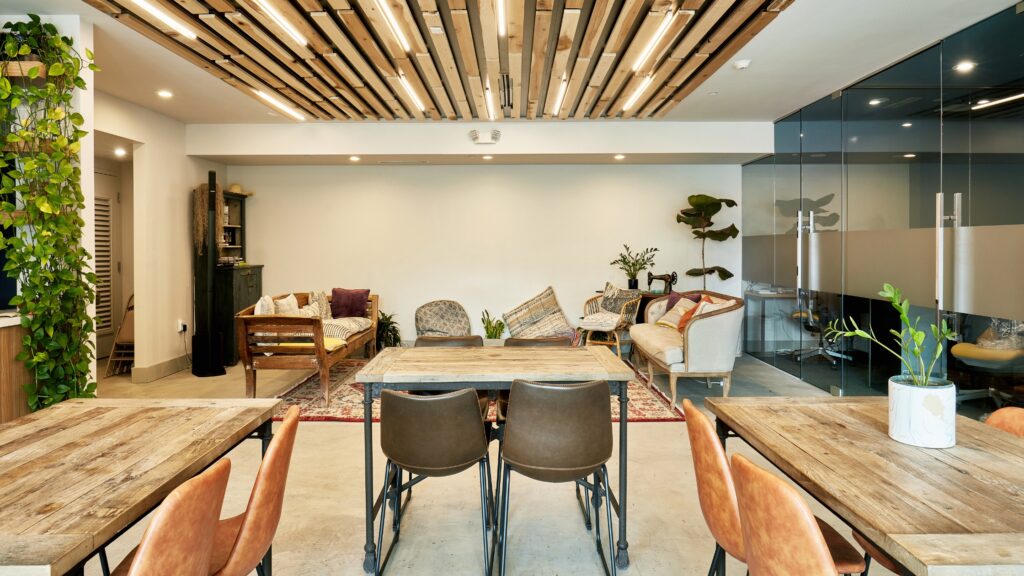Curating Community Through Collaborative Space

The following is a case study.
Organization: Roam Innovative Workplace
Size: 40
Industry: Co-Working & Meeting Space
Challenge: Creating a collaborative, dynamic workplace that fosters community
We all want a productive environment in which to do our work. Agile workplaces—and agile people— thrive in a community-driven environment. Yet for most, the challenge remains: How do we effectively create that community?
When I was preparing to launch LDR21, I was looking for a place to work that was a quieter alternative to a coffee shop. I needed to be around the energy of productive people, required a quiet space to take calls, and didn’t want every ounce of me to smell like coffee at the end of a day. I knew about co-working spaces, but none of the known leaders in metropolitan areas suited me. Those spaces offer great services, but I wanted more than mail delivery and free coffee.
By nature, I enjoy people and conversations. I want to find new and interesting people to talk to and learn from. It’s one of the reasons the open way is so appealing to me: it’s community-driven. So when I found Roam and took my first tour, I was hooked immediately. The staff welcomed me with smiles, open arms, laughter, and an immediate sense of belonging. I didn’t even sleep on it; I signed us up and immediately felt at home (we even joke that I’m part of their team because I talk them up so much). But honestly, isn’t that what the support of a community is about?
Roam Innovative Workplace is based in the Atlanta, GA, market and has been scaling rather nicely over the last couple of years. Their approach to coworking is different than most other companies in their industry. They wanted to reimagine collaborative, inclusive space. They don’t simply offer private offices and open coworking space; they also provide meeting space for the business community. And, frankly, it is how they “do community” that is their biggest difference.
In this case study, I want to explain Roam’s approach to a truly communal, collaborative space. Then I’ll address how you can translate that approach into strategies for reimagining your own workplace so it’s more community-oriented.
Partnering through community
I sat down with Corey Wardell, General Manager, and Chad Kimberlin, Director of Operations, both of whom I’ve come to know quite well. I wanted to know how they were carving out a niche within a niche market—and in an exploding industry.
Roam’s, tagline is “partners in the stories of accomplished dreams.” Their mission is to champion connections in a way that allows their community to grow together in knowledge and ability for the good of all. This is particularly evident in how they care for their members: Taking the time to listen to who they are and what they’re doing is only one of the many steps in caring for those in community. Chad simply stated, “We care about the success of our members. We want you to win.”
Several community-oriented principles guide Roam’s approach to building workplaces:
- Be engaged
- Create value
- Be intentional
- Be purposeful and impactful
- Initiate creativity
- Be generous and empower those in your community
As Corey told me: “I think community can just get thrown out and becomes a buzzword. But, I think when you put the meat behind it—it’s actually incredibly valuable.”
Yes, community is incredibly valuable—but many of us don’t know how to incorporate that into our workplace. Let’s take a look at four ways we can curate community in the workplace: through access, through support, through collaboration, and through sharing.
Why community?
We all have an innate need to be part of something bigger than ourselves; it’s how we’re hardwired. Community allows us to find that place we can belong and to which we can really contribute, and this leads to our feeling valued and purposeful. Understanding the value of our contributions—and the ways those contributions affect the ecosystems of which we’re all a part—creates a freedom and sense of ownership in all areas of our work.
As long as humans have been recording our history, we’ve had examples of community to learn about and emulate. We all have heard the maxim ”It takes a village to raise a child”—and so it did. Everyone in community has a job, a responsibility, in caring for each other. That’s always been the case. It may have looked like hunting for food, caring for children, harvesting fields together, or another task that helped everyone and everything work together towards a greater good.
Over time, our communities transitioned. Today, even though we’re banding together for more than just our survival needs, we are in great need of curating community one more again.
We need human connection, purpose, and value in our day to day interactions. And with digital transformation, we have the opportunity to create places of connection and valuable contribution, and to build societies together for successful futures.
Insight from Roam: “People just want to be connected and passionate about what they’re doing,” Corey told me. “We would really love to love to go to work and love to do what we do.” Roam’s job, he explained, is to create an environment for people to do their best work. It’s about an environment where you can be productive, you can focus, you can collaborate as you need to on your own terms. Roam recognizes that different people have different needs, so designing a workplace with a flexible framework is important. That framework has to include the right technology, seating arrangements, and even the right types of furniture. It’s all part of setting people up for success. Allowing people to work from home, while beneficial, can inadvertently create another issue: people not being productive. They need the environment, too, which is where coworking can come in to solve the real estate footprint and flexibility challenges.
Curate through access
In open organizations, we leverage open principles to create collaborative and inclusive environments. We seek to break down the barriers that would otherwise prevent knowledge sharing, communication, and the ability to collaborate. Removing barriers is part of providing access and support in the workplace.
The best place to start removing barriers is with access to information and ability to have open communication. By creating knowledge commons, best practice repositories, and open feedback practices, you can begin to remove silos and see an immediate increase in productivity and efficiency. If we want to build agile people, we must remove existing barriers for them to become agile. The barriers in the actual workspace can be the space itself, the tools and feedback mechanisms you use (or don’t use!), and the way you structure access to various resources.
Insight from Roam: As leaders in agile workplaces, we must help to remove barriers that prevent people from being innovative and creative, and from building new business. Roam understands that people need access to the right space, supplies, technology, support, and communication. In order for people to succeed, as employees or entrepreneurs, they must have access to resources and services to allow them to effectively do their jobs and succeed.
Curate through support
Asking people to show up on time, sit in a cubicle, and accomplish assigned tasks is not the way to go. It may have been the way for decades—but it isn’t conducive to how we work today. We have changed as a society; generational needs vary, and we operate in a global marketplace that demands constant evolution and improvement.
Without your people, you couldn’t run your organization, deliver services, or build products. As a leader, your people’s needs must be at the forefront of your mind. It isn’t about knocking out a wish list (ping pong tables or hammocks for rest or play). It isn’t always about the best benefit packages. It is about understanding the needs—the levels of access and support required—and getting into the trenches to walk it out with
So instead, let’s start with these questions: What do they need to actually do their job? What information can I get them? What type support system do we have in place? How do I retain great talent? How do we build bridges to close gaps? What do they need to hear from me as a leader?
Insight from Roam: “The idea of community comes into place when we engage the members in our space, put ourselves in their shoes, understand their struggles, and walk it out with them” Corey explained to me. “Our question is always: How do we help them succeed?” For Roam, part of the answer is providing access to others who will help them with their work. That means connecting people to others across teams, or helping them collaborate to solve a problem. You can provide access and support by connecting others in the community. Get to know what your people need and what they are great at. Then you can create bridges across the community to get things done—come alongside people and help them succeed. We are all acting on common interests with common goals; leverage that to foster community authentically.
Curate through collaboration
As an extrovert, I need conversation to sustain me. I need to be around people to keep my energy up. But community is more than an energizing group of people; it’s the combined effect of collaboration, inclusion, and support from others that makes it what it is. (I can personally say that I’ve previously failed in my efforts simply because I didn’t have community or collaborative people around me.)
In other words, it’s the product of an entire ecosystem of relationships. Recently I defined an ecosystem as: a living, breathing network of people and organizational frameworks. It’s a network of various actors that interconnect to form the system in which your organization operates. The actors in any ecosystem—employees, partners, external stakeholders, customers, vendors, etc.—are mutually dependent on each other for our business health, growth, and success. No matter your industry or current workplace style, perhaps our takeaway here is that—in order to foster community—people come first.
Creating places for collaboration at inclusive tables will become the engine behind the community. And knowing how we contribute to the ecosystem as a whole will strengthen our engagement in the community. People, no matter their role in the ecosystem, need to know and understand their place and the value of their contribution to the system. Our ecosystems are micro-communities connected to other micro-communities that all merge into the larger community. Our interdependence must be an understood value in order to foster community.
In order to have a healthy workplace, we need community. We need to feel comfortable, to feel supported, and to have a sense of adventure and connection to our work. We become extensions of each other who leverage positive intent in our interactions towards common goals.
Insight from Roam: One of the greatest things about the Roam community is the ability to connect others. As Corey said to me:
“Since we invest in knowing our people—who they are, what they do, what their needs are—we are able to play the ‘Have you met _______?’ game. We love engaging with the members because we are picking each others brains. Not only do we enjoy collaborating with our community, and making collaborative connections, the diversity of thought that comes with inclusion is invaluable. It gives us a way to ask “What is working and what is not?” so we can provide great service to our members. But, it also lets us hear about new ways of doing things that allows us to build and create right alongside of our members in our community. We believe that our members become an extension of our brand and vice versa. When meetings our hosted here we become an extension of our clients brand. We support them and solve their immediate challenges as their business partner. It is the culture we promote—to foster collaborative community that is a true partnership.”
The way you do work, the workplace itself, has a massive impact on culture in an organization. Every day, the spaces Roam provides create creates entry points for people to engage and become a part of a larger community. So create a workplace model that allows for bringing all types of people together to do better work—together.
Curate through sharing
Transparency in leadership, and the workplace, can be about sharing our failures as much as our wins—communicating with others about what is or isn’t working. This level of transparency allows collaborative teams to come together to positively contribute, and to either celebrate with you or offer help during a challenge. Collaborative communities connect deeply over time over common sets of ideas, values, or goals. It becomes about all of us rather than some of us (or ourselves).
With that sense of belonging we create in community, we are able to create places of trust that allow for us to connect at the human level and do life—and work—together.
Insight from Roam: “We talk about partnering in accomplishing dreams,” Chad said to me. “We all celebrate your wins with you. So that’s the idea of community, right? We become your coworker. We become your colleague. We become the extension of your team. We are your team. And it’s my favorite part for sure—this positive contribution.” One of the most important aspects of community is being there for each other. If someone in your community—a member, staff, or external client—needs something, you’ll need to come together to support them and, if you can, provide a solution. Serving your community extends beyond the workplace and workweek. We become extensions of each other’s teams in this kind of environment. “Frequently, we will have someone come straight up to the front desk after a call to share about a new client they just won or another exciting piece of news,” Corey said.
It takes five
For me, the aspect community is vital to an open organization. But you can’t curate community without inclusivity. And great communities also don’t happen without transparency and collaboration. That’s why the presence of all five open principles are necessary for creating and sustaining a successful environment.
This content was originally published in The Open Organization Workbook (2018).
In The Open Organization Workbook, more than 25 managers, leaders, consultants, and other practitioners answer that question with their favorite tips for building organizations that are more transparent, inclusive, adaptable, collaborative, and communal. Download the book.







Responses